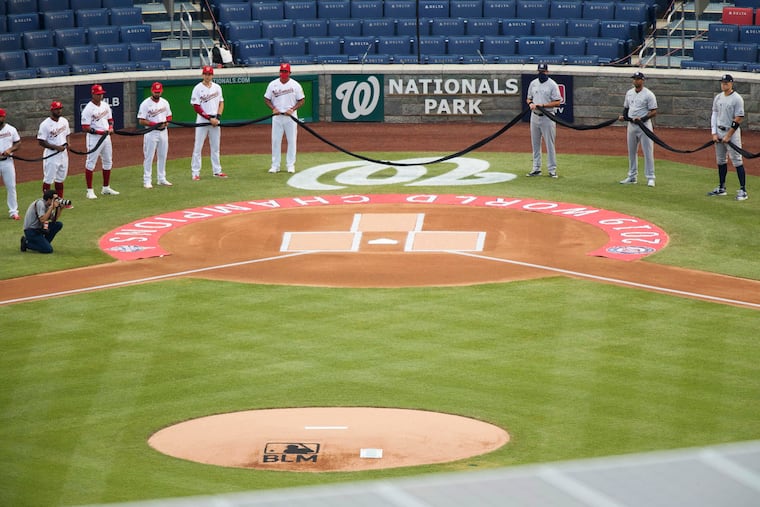Watching baseball in an empty stadium is weirder than I thought | David Murphy
The Yankees and Nationals opened the strangest of seasons, and TV could not hide the oddity of it all.

When my editor asked if I’d write a column about Thursday night’s Yankees-Nationals tilt, I figured there were worst ways to spend a Thursday night than watching the first opening day in modern history to be held entirely without fans. I’d sit back, crack a beer, crack some jokes, and maybe beat my personal record of angry emails from middle-aged dudes who are still smarting that they took the games off the AM dial. I’d file an absurd column about an absurd night and then slip back into sweet, sweet depression.
And, hey, that’s still probably what this will end up being. But first, I have to be honest. I was only two innings into ESPN’s broadcast when I actually found myself feeling a faint flicker of something that a psychologist would tell me is an actual emotion. I don’t know if sadness is the appropriate word. There are lots of sad things in the world right now, and baseball in an empty stadium wouldn’t even crack the Letterman list. Instead, I think what I felt would be better termed as “empty.”
Or, at least, I felt the emptiness. Because, really, there was no way for the cameras to hide it. Turns out, when you take away all of the fans and the game day staff and the concessionaires and the mascots and all of the other textured, colorful things that typically ebb and flow in the background of your television screen while a baseball game is being played, what you’re left with is 900 cubic inches or so of human beings and about 17 million cubic feet of empty space.
Heading into the night, I was aware of the unique visual challenges that baseball and ESPN’s production crew would face, but I don’t think I grasped the level of synchrony that typically exists between the sport’s usual backdrop and the game. I figured the broadcasts would look more or less like they have on the PGA Tour, or during the NBA’s scrimmages. The lack of people in the stands would be a little weird, sure, but let’s keep in mind that we once watched the Phillies play a couple of World Series games at Tropicana Field. I mean, say what you will about Rays fans, but they were way ahead of the curve on this social distancing thing.
Yet even on the nights with the sparsest of gates, you still had a backdrop that more or less looked alive. You might not be able to track a home run ball from launch to landing, but your eyes would naturally flit back and forth between the retreating outfielder and the gathering fans. Maybe the most dramatic moments in any game lie in the tension of this convergence between life on the field of play and life on the other side. Usually, when Giancarlo Stanton hits a home run, you can more or less approximate its magnitude by the reaction of the fans. On Thursday night, when he crushed the first home run of what is shaping up to be another bountiful season, the lack of depth and texture in its landing spot almost seemed to relegate the hit itself to two dimensions.
Earlier in the broadcast, there was a moment when play-by-play announcer Matt Vasgersian noted that, from the national anthem to the lineup announcements, the Nationals were attempting to make the game feel as normal as possible. But, as is often the case with such a strategy, the result was that it only felt weirder. As the Nationals’ PA announcer shouted Kurt Suzuki’s name into the void, the camera cut to the Nationals catcher just as he was unsuccessfully stifling a yawn.
Heading into the night, as far as I was concerned, baseball had one job. Don’t mess it up for football. Play your 60 games, wipe down your common surfaces, and maybe we’ll make it to September without having drawn any more attention to ourselves. Because if they take football from us, I’m not sure we’ll even make it long enough to watch the world fall apart on Election Day. I don’t mean to be melodramatic, but if there is no football to watch after Daylight Savings, I will probably turn into a cockroach.
That’s not to say that I don’t want this baseball season to matter. I assume that if you’ve made it this far you understand what I do for a living. Beyond my professional investment, I think our society is currently in desperate need of some politically neutral discussion topics.
That being said, if we really do need a compelling baseball season, Day 1 was an ominous beginning. Hours before their opener against the Yankees, the Nationals announced that the best player in their lineup would miss an extended period of time after testing positive for COVID-19. A little while after the game lost Juan Soto, news came from Los Angeles that the Dodgers were placing Clayton Kershaw on the injured list.
Even in a perfect world, baseball was going to struggle to convince people of the integrity of a 60-game season. Last year, the Nationals were 19-31 through 50 games. They ended up winning the World Series.
Maybe it’s just me. It often is. Or maybe the vibe will be different when the Phillies take the field. But we’ve got a long winter ahead of us, and the days are still long, and on Friday I’m going golfing.